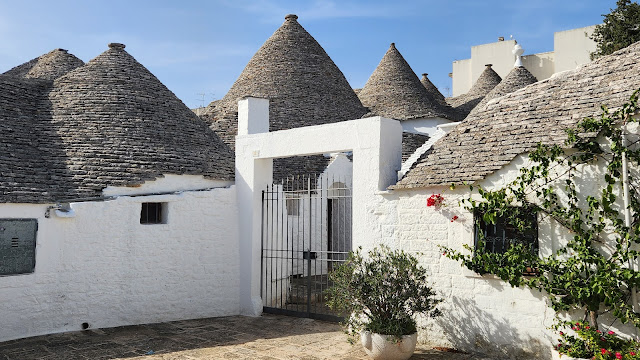Alberobello ⭐⭐is known as the "Capital of Trulli." Trulli are built using a traditional dry stone construction technique, which means that no mortar or cement is used. The walls are made of thick layers of limestone, and the roofs are conical in shape. The roof of a trullo is typically a conical vault, which is made of stone voussoirs, and they are often topped with a pinnacle, which is a decorative stone ornament.
Over 1,500 trulli grace the landscape of Alberobello, designated as a UNESCO World Heritage Site, and these distinctive dwellings now serve primarily as shops, restaurants, and hotels.
Photo Gallery
Typical Construction Technique of a Trullo of Alberobello
 |
| Model of a trullo (Marcok di it:Wikipedia, CC BY-SA 3.0, via Wikimedia Commons) |
Foundations
The construction of a trullo begins with the preparation of the foundations. This involves digging a trench and filling it with rubble stones. The walls are then built directly on top of the rubble foundation.
Walls
The walls of a trullo are typically made of limestone, which is a locally abundant material. The limestone is carefully shaped into rectangular blocks, which are then stacked without mortar. This dry-stone construction technique is a distinctive feature of trulli.
Cavity and Stone Rubble
The space between the inner ashlar wall face and the exterior covering of stone tiles or chiancharelle is filled with stone rubble. This stone rubble provides insulation and helps to stabilize the structure.
Vault
The roof of a trullo is typically a conical vault, which is made of stone voussoirs. Voussoirs are wedge-shaped stones that are carefully arranged to form a self-supporting arch. The conical shape of the vault helps to distribute the weight of the roof evenly.
Exterior Covering
The exterior of the trullo is typically covered with chiancharelle, which are thin limestone slabs. The chiancharelle are laid in a herringbone pattern, which adds to the beauty of the trullo.
Significance of the Construction Technique
The construction technique of trulli is a significant part of Apulian culture. It is a unique and sustainable building technique that has been passed down from generation to generation.
















No comments:
Post a Comment
Note: Only a member of this blog may post a comment.